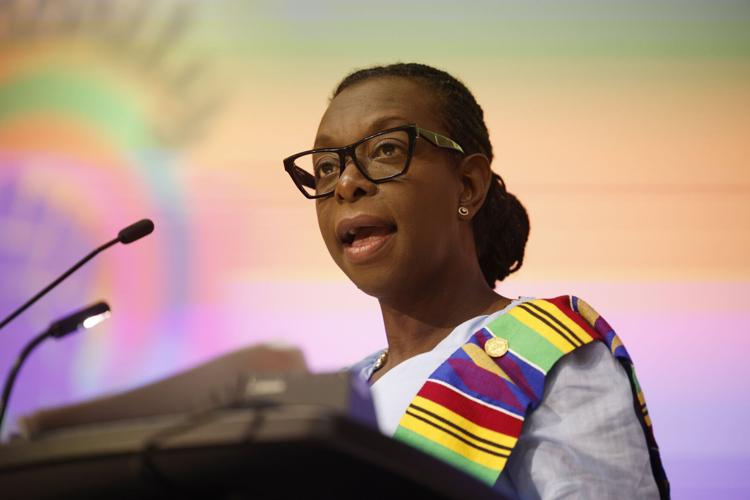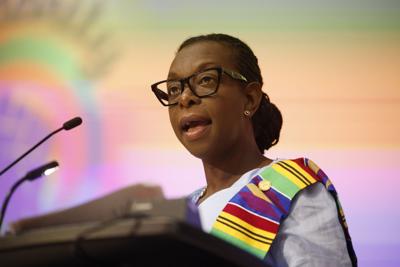The province’s education minister has “very little respect” for trustees, and putting five school boards under ²õ³Ü±è±ð°ù±¹¾±²õ¾±´Ç²ÔÌýhas left too many familiesÌý·É¾±³Ù³ó´Ç³Ü³Ù an elected ´Ç´Ú´Ú¾±³¦¾±²¹±ôÌýto turn to, says the president of the Elementary Teachers’ Federation of Ontario.
Karen Brown, speaking Monday afternoon at her union’s annual general meeting, said “almost one-third of all students in Ontario (are) going to school in boards without trustee representation ... Parents struggling to get the appropriate special education support for their child now need to reach out to their members of provincial parliament to engage in that kind of lobbying, since trustees are not there.”
Democratically elected school boards “provide community members with a voice and a direct stake in public education,” she also told members gathered at a downtown ÎÚÑ»´«Ã½ hotel, calling trustees’ “critical” to the system.
At the end of the school year, Education Minister Paul Calandra put the ÎÚÑ»´«Ã½ public and Catholic boards under the control of a provincial appointee, as well as the Ottawa-Carleton public and Dufferin-Peel Catholic boards, citing financial mismanagement. He had earlier placed the Thames Valley public board under supervision.Â
While some parents and trustees have labelled the move anti-democratic, others hope it will lead to better governance.Â
Brown told the Star that “we believe that (school board) autonomy should be there. Every area is different — communities should be able to trust” that the individuals they’ve elected represent their interests.
In her speech, Brown said while the next round of bargaining talks won’t happen until next year — all education contracts are up at the end of next August — the union is already “laying the groundwork for bold, focused action” and the issue of class size will be the top priority.
“For years, educators have been clear — smaller class sizes are essential to student learning and educator well-being,” Brown said. “We’ve seen how overcrowded classrooms limit what’s possible, how they stretch educators too thin, reduce opportunities for individualized support, and make it harder to create the kind of calm, safe and inclusive spaces our students deserve.”
Smaller classes, she added, “are not a luxury. They are foundational to a high-quality public education system, and key to addressing the growing challenges we face every day.”
In Ontario, while most classes in grades 1 to 3 are capped at 20 students, funding for grades 4 to 8 is based on an average of 24.5 students — but because that is an average, some classes are much larger.
Brown said some classes have ballooned to more than 30 of “students with varying needs,” and the union wants the government to implement a cap of 24.
Kindergarten classes, which are taught by a teacher and early childhood educator, should be capped at 26, she added, instead of the current rules that set a cap of 29, though in some cases classes can hit a maximum of 32.
The union is already “laying the groundwork for bold, focused action” in advance of bargaining, with the slogan “smaller classes, BIG DIFFERENCE.”
“This campaign reflects what our members have told us loudly and clearly, that reducing class sizes must be a top priority,” Brown also said. “It’s how we tackle chronic underfunding. It’s how we address rising school violence. It’s how we improve teacher and education worker retention. And it’s how we ensure that every student, in every corner of this province, gets the attention and support they need to thrive.”
While the government is working to hire additional teachers amid a shortage, Brown said the real issue is in both recruiting and retaining educators.
“It is not a shortage,” she said, adding the government “will explain it away by saying teachers are taking too many sick days. Of course, their answer often misses the point. There are deeply rooted systemic issues in our schools that are leading to more days away from the classroom and fewer occasional teachers who are willing to place themselves in those conditions. The solution is systemic change, not blaming you, the workers.”
In an interview, Brown said she raised the issue of class sizes in a meeting with Calandra in July.
“The classrooms are overcrowded,” she said, adding “smaller class sizes will help to address some of the underlying root issues that impact overall learning and teaching.”
The elementary teachers’ union is the largest in the country, with 84,000 members who are teachers, early childhood educators and other school support staff.
Meanwhile, ÎÚÑ»´«Ã½ District School Board trustees who wrote to the provincial ombudsman earlier last week asking him to ensure parent voices are heard while the board is under supervision, received a response Thursday.
“My office will begin a review of your concerns, consistent with our processes,” wrote Paul Dubé.
The trustees are concerned that parents are being kept in the dark regarding decisions. In contrast, the supervisor at the Ottawa board contacted parents via email in July, saying he’d met with some staff, trustees and families and has “asked staff to take extra steps to ensure the district remains open and responsive.”
































To join the conversation set a first and last name in your user profile.
Sign in or register for free to join the Conversation